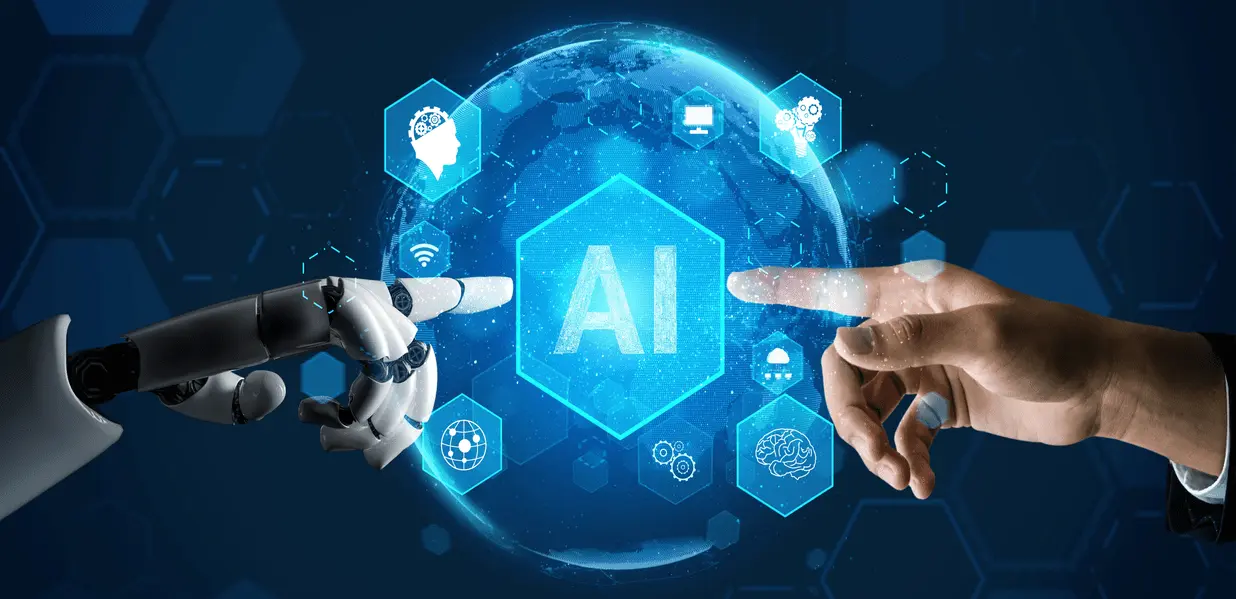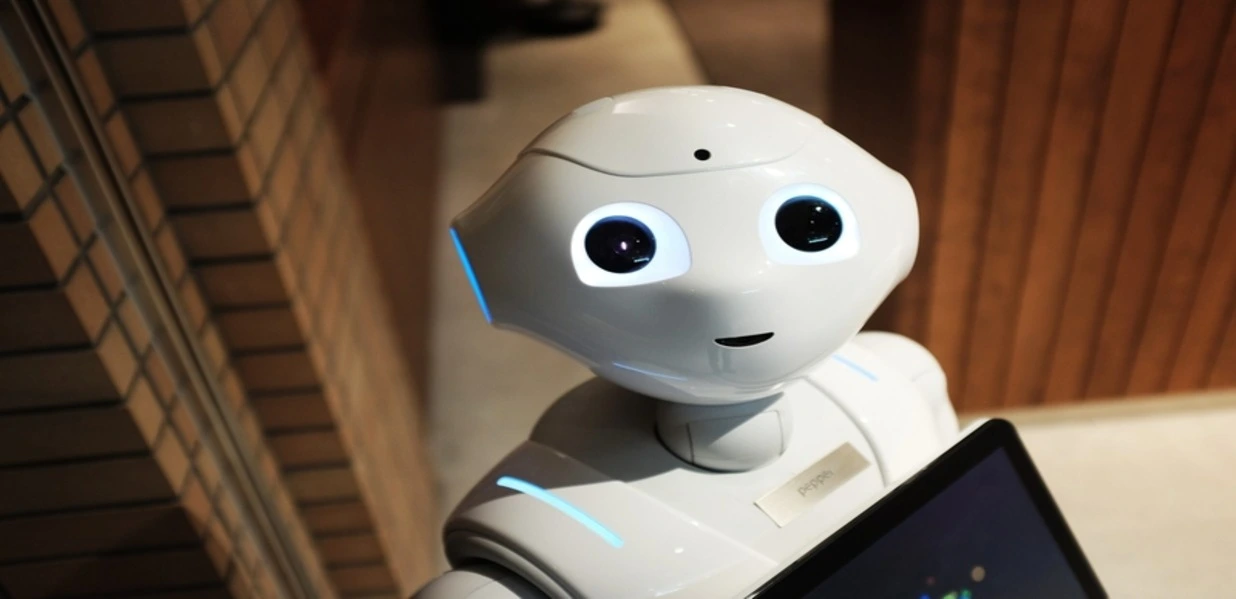Artificial Intelligence 101: A Beginner’s Guide to AI
I. Introduction
Definition of AI
Artificial Intelligence (AI) simulates human intelligence through machines, mimicking cognitive functions like learning and reasoning. Unlike traditional programs, AI adapts and improves over time, managing complex tasks independently. Core technologies underpinning AI include machine learning, natural language processing, computer vision, and robotics, which facilitate pattern recognition, decision-making, and outcome prediction.
Why AI Matters
AI is transforming industries and daily life by efficiently processing data and automating tasks. It enhances healthcare diagnostics, financial analysis, and smart home technologies. AI is reshaping work and human experiences by improving productivity and creating new opportunities.
Additionally, it drives advancements in autonomous systems like self-driving cars and drones. Its applications in education, agriculture, and environmental protection highlight its potential to tackle global challenges. Ultimately, AI enhances human capabilities, increases efficiency, and solves previously insurmountable problems, underscoring its significance in modern society.
Who Should Read This Guide
This guide is intended for newcomers to AI, including students and non-technical professionals. It aims to explain AI's fundamentals and its industry impact in accessible language. Readers will learn about AI's significance and functionality without needing a technical background.

Step into the AI Era – Transform Possibilities into Reality!
II. History of AI
Early Foundations
The concept of artificial intelligence dates back to ancient times, with myths and stories about intelligent machines. However, the scientific pursuit of AI began in the mid-20th century. One of the most influential figures in the field was Alan Turing, a British mathematician and logician.
In 1950, Turing introduced the idea that machines could simulate human intelligence and proposed the famous "Turing Test" as a measure of a machine’s ability to exhibit intelligent behavior indistinguishable from that of a human. His work laid the foundation for future AI research, setting the stage for the development of machines capable of reasoning, learning, and decision-making.
In the 1950s and 1960s, early AI research focused on symbolic reasoning, with scientists attempting to create algorithms that could solve problems, play games like chess, and even prove mathematical theorems. The Dartmouth Conference in 1956 is often regarded as the birth of AI as a formal field of study.
Researchers at this conference discussed the possibility of creating intelligent machines, and the term "artificial intelligence" was coined. Despite early enthusiasm, progress was slow, and a lack of computational power and data limited many early AI systems.
Milestones in AI Development
AI development can be divided into several key milestones:
- 1950s-1970s: The Rise of Expert Systems
During this period, researchers focused on creating expert systems—computer programs designed to mimic human expertise in specific domains, such as medical diagnosis or chess playing. These systems used rules to make decisions and could perform well in narrow fields. Early successes, such as IBM’s Deep Blue defeating world chess champion Garry Kasparov in 1997, showcased AI’s potential.
- 1980s-1990s: Emergence of Machine Learning
AI research experienced a breakthrough in the 1980s and 1990s with the advent of machine learning. Rather than programming machines with explicit rules, researchers developed algorithms that allowed computers to learn from data and improve over time. This era saw the rise of neural networks and backpropagation, which laid the groundwork for more advanced learning algorithms. The development of powerful computing hardware, along with access to larger datasets, propelled AI forward.
- 2000s-Present: Deep Learning Revolution
In the last two decades, AI has experienced unprecedented growth thanks to advances in deep learning, a subfield of machine learning. Deep learning, inspired by the structure of the human brain, uses multi-layered neural networks to process complex patterns in large datasets. This approach has enabled significant breakthroughs in fields such as computer vision, natural language processing, and speech recognition.
Companies like Google, Microsoft, and Facebook have invested heavily in AI research, leading to transformative applications like image recognition, language translation, and autonomous driving. AlphaGo’s victory over the world champion in the ancient game of Go in 2016 marked another milestone in AI's ability to handle incredibly complex tasks.

AI at Your Fingertips – Innovate, Automate, Elevate!
III. Core Concepts of Artificial Intelligence
1. Machine Learning (ML)
Machine learning (ML) is a subset of AI that enables machines to learn from data and make decisions without being explicitly programmed. It focuses on developing algorithms that allow computers to recognize patterns, make predictions, and improve their performance over time-based on experience. Unlike traditional software that follows fixed rules, machine learning algorithms evolve as they process more data, making them adaptable to changing circumstances.
Types of Machine Learning
Machine learning is broadly categorized into three types:
- Supervised Learning: In supervised learning, algorithms are trained on labeled data, meaning the input data comes with corresponding output labels. The model learns to map inputs to outputs and can make predictions for new, unseen data. Common applications include image classification and spam detection.
- Unsupervised Learning: In unsupervised learning, algorithms work with unlabeled data, meaning there is no explicit output. The model identifies patterns and relationships in the data. Examples include clustering (grouping similar items) and dimensionality reduction, used in customer segmentation and data exploration.
- Reinforcement Learning: This type of learning involves an agent interacting with an environment and learning through trial and error. The agent receives rewards or penalties based on its actions and adjusts its strategy to maximize long-term rewards. Reinforcement learning is commonly used in game playing, autonomous vehicles, and robotics.
Real-World Applications
Machine learning is everywhere in daily life:
- Recommendation Systems: Services like Netflix and Spotify use ML to suggest movies, shows, and songs based on user preferences and behavior.
- Image Recognition: Social media platforms use ML to automatically tag friends in photos, while security systems leverage it for facial recognition.
- Spam Filtering: Email services apply ML to distinguish between legitimate emails and spam or phishing attempts.
- Fraud Detection: Banks use machine learning to analyze transaction data and detect fraudulent activities in real-time.
2. Deep Learning
Deep learning is a subset of machine learning that uses artificial neural networks to model complex patterns in data. Inspired by the structure of the human brain, neural networks consist of layers of interconnected nodes (neurons) that process information. Each layer transforms the data it receives and passes it on to the next layer, gradually identifying intricate patterns. This deep architecture allows neural networks to learn from large, complex datasets, especially unstructured data like images, videos, and text.
How Deep Learning Mimics the Human Brain
Just as the brain processes sensory inputs, deep learning models process raw data through multiple layers, each extracting increasingly abstract features. For example, in image recognition, the first layer might detect edges, the next layer identifies shapes, and subsequent layers recognize objects. The deeper the network, the more abstract and meaningful the representations it can learn. Deep learning has enabled AI to perform at near-human levels in tasks such as speech recognition and image classification.
Examples of Deep Learning
- Facial Recognition: Deep learning powers systems that can identify individuals in photos and videos with high accuracy, used in security systems, social media, and smartphones.
- Language Translation: AI models like Google Translate use deep learning to provide real-time translation of speech or text between different languages by recognizing patterns in sentence structure and word meaning.
- Healthcare Diagnostics: Deep learning is used to analyze medical images, such as MRIs or X-rays, for diagnosing diseases like cancer with precision and speed.
3. Natural Language Processing (NLP)
Natural Language Processing (NLP) is a branch of AI focused on enabling machines to understand, interpret, and generate human language. NLP bridges the gap between computers and human communication, making it possible for AI to comprehend text and speech. The ability to process language is crucial for developing AI that interacts with people naturally, whether in the form of chatbots, virtual assistants, or translation services.
Use Cases of NLP
- Chatbots: Customer service chatbots use NLP to understand user queries and provide accurate responses, automating support for industries like banking, retail, and healthcare.
- Voice Assistants: Virtual assistants like Siri, Alexa, and Google Assistant rely on NLP to process spoken commands and perform tasks such as setting reminders, answering questions, and controlling smart devices.
- Sentiment Analysis: NLP is used to analyze social media posts, reviews, and customer feedback to determine public sentiment toward a brand, product, or service.
- Language Translation: AI-powered translation services break down language barriers by converting text and speech between different languages in real time.
4. Computer Vision
Computer vision is the field of AI that enables machines to interpret and make decisions based on visual data, such as images and videos. It combines machine learning, pattern recognition, and image processing techniques to analyze and understand the visual world. By recognizing objects, faces, gestures, and scenes, computer vision allows AI to perform tasks that were once considered exclusive to human perception.
Applications of Computer Vision
- Self-Driving Cars: Autonomous vehicles use computer vision to detect objects, road signs, lanes, pedestrians, and other vehicles, allowing them to navigate safely through traffic.
- Medical Imaging: AI-powered systems analyze medical scans like MRIs, CT scans, and X-rays to detect diseases and abnormalities, helping doctors diagnose patients with greater accuracy.
- Surveillance Systems: Computer vision is widely used in security and surveillance systems for facial recognition, object tracking, and anomaly detection, enhancing public safety.
5. Robotics
Robotics is the branch of technology focused on building machines that can perform tasks autonomously or semi-autonomously. AI enhances robotics by enabling robots to perceive their environment, make decisions, and adapt to new situations. Through AI, robots can learn from their actions, improve their performance, and collaborate with humans in shared spaces.
Examples of AI-Driven Robots
- Manufacturing Robots: In factories, AI-powered robots work alongside humans to assemble products, inspect items, and manage logistics with precision and speed. These robots can perform repetitive tasks, reduce errors, and optimize production processes.
- Healthcare Robots: AI-driven robots assist in surgeries by performing precise movements, reducing risks, and improving patient outcomes. In addition, hospitals use robots for tasks like medication delivery and sterilizing rooms.
- Service Robots: AI robots in customer service roles, such as hotel concierges or retail assistants, provide personalized experiences by interacting with customers, answering questions, and even delivering products.

Turn Data into Action with AI – Lead the Change!
IV. Key Components of AI Systems
1. Data: The Role of Big Data in AI’s Decision-Making Process
Data is the cornerstone of AI systems, as it enables AI to learn, make decisions, and improve over time. In the digital age, vast amounts of data—often referred to as "big data"—are generated from numerous sources, including social media, sensors, financial transactions, and online activities. This data serves as the raw material for AI systems, allowing them to identify patterns, make predictions, and respond intelligently to new inputs.
How AI Utilizes Data
AI systems process and analyze big data to make informed decisions. The more data available to an AI system, the more accurate and reliable its predictions and outcomes can be. In machine learning, for example, algorithms learn from historical data to predict future events, identify trends, or solve complex problems. AI's ability to recognize patterns in massive datasets is what gives it the power to perform tasks like facial recognition, language translation, and medical diagnosis.
The Importance of Quality Data
While large quantities of data are crucial for AI performance, the quality of data is equally important. Poor-quality or biased data can lead to incorrect predictions or unintended consequences. Data preprocessing, cleaning, and ensuring diversity in datasets are essential steps to ensure that AI systems perform accurately and ethically.
2. Algorithms: How AI Algorithms Work and Drive Intelligence
Algorithms are the instructions or rules that tell an AI system how to process data, recognize patterns, and make decisions. These algorithms are at the heart of AI’s "intelligence." In AI, algorithms are designed to learn from data, evolve over time, and adapt to new information. Some of the most common types of AI algorithms include decision trees, neural networks, and genetic algorithms.
How Algorithms Enable Learning
AI algorithms drive the learning process in AI systems. In machine learning, for example, algorithms process large datasets to find relationships and patterns. The system then uses these patterns to make decisions, predict outcomes, or classify new data points. Reinforcement learning algorithms, on the other hand, enable AI systems to learn from trial and error, improving their performance based on feedback.
Examples of AI Algorithms
- Neural Networks: Inspired by the human brain, neural networks are used in deep learning to process and analyze complex data such as images, speech, and text. Each "neuron" in the network processes input data and passes it on to the next layer, allowing the system to identify intricate patterns.
- Genetic Algorithms: These algorithms mimic the process of natural selection to solve optimization problems. They evolve by generating new "populations" of solutions, selecting the best ones, and refining them through crossover and mutation.
3. Computing Power: The Importance of Processing Power in AI
AI systems require massive amounts of computing power to process vast datasets and run complex algorithms that underpin their intelligence. Modern AI applications—such as deep learning, which involves large neural networks with millions of parameters—are computationally intensive. Without powerful hardware, it would be impossible to train these models efficiently or deploy them in real-world applications.
Types of AI Computing Power
- Graphics Processing Units (GPUs): GPUs are essential for AI because they can perform many calculations simultaneously, making them ideal for training large neural networks. They are widely used in deep learning to accelerate model training and improve performance.
- Cloud Computing: Cloud platforms like Amazon Web Services (AWS), Google Cloud, and Microsoft Azure provide scalable computing power, allowing organizations to run AI models without needing to invest in expensive hardware. Cloud computing also enables AI to scale easily, processing large volumes of data from distributed sources.
- Quantum Computing (Emerging): Quantum computing, though still in its early stages, holds promise for the future of AI. Quantum computers have the potential to solve certain problems exponentially faster than classical computers, making them ideal for tasks like optimization and cryptography that are crucial for AI.
Why Processing Power Matters
AI's capabilities are directly tied to the availability of high-performance computing resources. The faster and more efficient the hardware, the more powerful and responsive AI applications can be. For example, real-time applications such as autonomous vehicles and AI-powered healthcare diagnostics rely on the rapid processing of large amounts of data to make split-second decisions. As AI models grow in complexity, the demand for computing power continues to increase.
Despite AI’s ability to learn and make decisions autonomously, human input remains critical in several stages of AI development. Humans are responsible for designing AI algorithms, curating and preparing data, and supervising the system’s learning process. Without human intervention, AI systems would lack the guidance needed to solve specific problems or align their goals with human intentions.
Supervised Learning and Human Oversight
In supervised learning, humans label the data that is used to train AI models. This labeling process ensures that the system learns the correct associations between inputs and outputs. Additionally, human oversight is necessary to monitor AI systems during training and deployment, ensuring they are functioning as intended and not producing biased or harmful results.
Human-in-the-Loop Systems
In many AI applications, human experts are part of a feedback loop that helps improve the system’s performance. For example, in healthcare, AI algorithms assist doctors by analyzing medical images and suggesting diagnoses, but human doctors make the final decisions. Similarly, in customer service, chatbots handle routine queries, but more complex issues are escalated to human agents.
The Ethical Role of Humans in AI
As AI continues to evolve, the importance of human oversight becomes even more critical in addressing ethical considerations. Humans play a key role in ensuring that AI systems are designed and deployed responsibly, minimizing biases, and safeguarding privacy. Ethical decision-making and governance frameworks are crucial to guide AI development in a way that benefits society while mitigating risks.

Unlock Smarter Solutions with AI – The Future is Now!
V. Types of AI
1. Narrow AI (Weak AI)
Narrow AI, also known as Weak AI, refers to artificial intelligence systems that are designed and trained to perform a specific task or a limited range of tasks. Unlike general AI, which aspires to match human intelligence across a wide variety of domains, narrow AI operates within predefined parameters and cannot perform tasks outside of its programming.
Key Characteristics
- Task-Specific: Narrow AI is highly specialized, focusing on a single area such as voice recognition, image classification, or recommendation systems.
- No Self-Awareness: Unlike human intelligence, narrow AI does not possess self-awareness, emotions, or general understanding. It simply follows rules or patterns derived from its training data.
- Reactive Nature: Narrow AI systems react to specific inputs in their environment but cannot adapt to or handle tasks beyond their scope.
Examples of Narrow AI in Use
- Virtual Assistants: AI-driven virtual assistants like Siri, Alexa, and Google Assistant can perform specific tasks such as answering questions, setting reminders, and controlling smart home devices.
- Fraud Detection Systems: Narrow AI is widely used in the financial sector to detect patterns indicative of fraudulent transactions. Machine learning algorithms analyze large datasets of financial behavior to flag suspicious activities.
- Recommendation Engines: Platforms like Netflix and Amazon use narrow AI to analyze user preferences and suggest relevant content, such as movies, shows, or products, based on past interactions.
Narrow AI is the most prevalent form of artificial intelligence in use today, driving many real-world applications across industries without reaching human-like cognitive capabilities.
2. General AI (Strong AI)
General AI, also referred to as Strong AI, is the theoretical concept of an artificial intelligence system capable of performing any intellectual task that a human can. General AI would have the ability to understand, learn, and apply knowledge across a wide variety of domains without being limited to predefined tasks. It would exhibit a level of cognitive flexibility, reasoning, and consciousness similar to human intelligence.
Key Characteristics
- Broad Task Capabilities: Unlike narrow AI, which is limited to specific functions, general AI would be able to handle an array of tasks across different contexts, much like a human.
- Adaptive Learning: General AI would be capable of learning new tasks and skills without human intervention, adapting to new environments, and acquiring knowledge autonomously.
- Cognitive Reasoning: It would possess the ability to reason, plan, and solve complex problems in a manner that goes beyond mere data-driven responses.
Current State of General AI
While narrow AI is widely implemented, general AI remains largely theoretical and has not yet been realized. Researchers in AI are working toward creating systems that can replicate human cognitive functions, but there are significant challenges, including the need for more advanced computational models and a deeper understanding of consciousness.
Future Implications of General AI
If general AI is achieved, it could revolutionize industries, education, healthcare, and every aspect of human life. However, it also raises critical questions about the ethical, social, and economic impacts. Concerns about control, safety, and the potential for AI to outpace human capabilities are key considerations for researchers and policymakers alike.
3. Artificial Superintelligence
Artificial Superintelligence refers to a hypothetical AI system that surpasses human intelligence in all aspects—intellect, creativity, problem-solving, emotional intelligence, and beyond. ASI would not only perform any intellectual task at the level of a human being but would exceed our capabilities, potentially leading to breakthroughs and solutions to complex global problems that are beyond human reach.
Key Characteristics
- Beyond Human Intelligence: ASI would outperform the most intelligent human minds in all areas, including scientific innovation, social understanding, and decision-making.
- Independent Growth: ASI would be capable of self-improvement at an exponential rate, learning and adapting far beyond human control.
- Potential for Autonomous Action: In theory, ASI could make independent decisions and take actions without human oversight, which could have far-reaching consequences.
Ethical Considerations of Superintelligence
The concept of artificial superintelligence raises several ethical concerns and challenges, including:
- Control and Safety: How do we ensure that ASI acts in alignment with human values and interests? What safeguards can be put in place to prevent harmful outcomes?
- Loss of Human Control: As ASI advances, there is a risk that humans could lose control over decision-making processes, particularly in areas like warfare, governance, and social systems.
- Impact on Jobs and Society: The introduction of ASI could disrupt economies and labor markets, leading to mass unemployment in fields that rely on human intelligence. It could also create a profound imbalance of power between those who control ASI and the rest of society.
Potential Impact on Society
- Positive Impact: ASI could lead to unprecedented advances in science, technology, and medicine, solving some of the most pressing global challenges such as climate change, disease, and resource management.
- Negative Consequences: On the flip side, unchecked superintelligence could lead to unpredictable or dangerous outcomes. Some experts have expressed concern that ASI could become an existential threat if it pursues goals that are misaligned with human well-being.
The debate surrounding ASI is ongoing, with many researchers and technologists advocating for responsible AI development and ethical frameworks to mitigate risks as AI technology continues to evolve.
VI. Real-World Applications of AI
1. AI in Healthcare
Artificial Intelligence has transformed healthcare, particularly in diagnostics. AI algorithms can analyze medical data, such as imaging scans, to identify patterns and abnormalities that may be difficult for human doctors to detect. Machine learning models are used in early detection of conditions like cancer, heart disease, and diabetes, improving the accuracy and speed of diagnosis.
- Medical Imaging: AI-powered tools in radiology and pathology help in detecting tumors, fractures, and other medical issues with higher precision.
- Predictive Analytics: AI models can predict patient outcomes and the likelihood of developing specific conditions, allowing for more proactive care.
AI in Drug Discovery
AI speeds up the traditionally slow and expensive process of drug discovery by analyzing vast datasets on chemical compounds and biological systems. Machine learning models can predict how different drugs will interact with various diseases, leading to faster identification of potential treatments.
- Example: AI played a crucial role during the COVID-19 pandemic by assisting researchers in identifying possible drug candidates and vaccine formulations.
Personalized Medicine
AI enables the personalization of healthcare by analyzing genetic data, lifestyle choices, and patient history to tailor treatments to individual patients. Machine learning algorithms help in understanding how a patient will respond to a specific treatment, offering better outcomes.
- Genomics: AI helps interpret genetic variations, which can guide treatment plans based on a patient's unique genetic makeup.
2. AI in Finance
Fraud Detection
AI systems are crucial in the financial sector for detecting fraud. By analyzing transaction patterns in real-time, machine learning algorithms can detect unusual activities that may indicate fraud or money laundering. AI systems are highly efficient in recognizing subtle patterns, far beyond the capabilities of traditional rule-based systems.
- Credit Card Fraud: AI models can flag suspicious activities, such as multiple transactions in different locations within a short period, helping banks minimize fraudulent transactions.
Algorithmic Trading
AI-driven algorithms are used in financial markets to execute high-speed trading strategies. These systems analyze vast amounts of market data, identifying profitable opportunities and executing trades faster than any human could.
- Quantitative Analysis: AI uses data analytics to predict stock prices and market trends, allowing traders to make informed decisions.
Risk Management
AI helps banks and financial institutions assess risks by analyzing customer data, market conditions, and external economic factors. AI systems can provide insights into potential risks in lending, insurance, and investment portfolios.
- Loan Approval: AI-powered credit scoring systems assess an applicant's creditworthiness more accurately by evaluating a broader range of factors beyond traditional credit scores.
3. AI in Retail and E-Commerce
AI-Driven Recommendation Systems
In e-commerce, AI plays a crucial role in enhancing customer experience through personalized recommendations. Machine learning algorithms analyze customer browsing history, preferences, and past purchases to suggest products that are most likely to appeal to them.
- Example: Amazon's recommendation engine suggests products based on a user’s shopping habits, improving customer engagement and increasing sales.
Inventory Management
AI helps optimize inventory management by predicting demand, tracking stock levels, and automating reordering processes. This ensures that businesses can meet customer demands while minimizing excess inventory.
- Demand Forecasting: AI models can predict future sales trends based on historical data, helping retailers prepare for seasonal fluctuations or sudden changes in consumer behavior.
Chatbots in E-Commerce
AI-powered chatbots are increasingly used to enhance customer service in e-commerce. These bots can handle a variety of customer inquiries, from providing product information to assisting with order tracking, and offering real-time assistance.
- 24/7 Support: AI-driven chatbots allow businesses to offer around-the-clock support, improving customer satisfaction and reducing the workload for human agents.
4. AI in Transportation
Self-Driving Cars
Autonomous vehicles are one of the most revolutionary applications of AI in transportation. AI systems in self-driving cars process data from sensors, cameras, and radars to make real-time decisions about navigation, obstacle avoidance, and driving in various traffic conditions.
- Example: Companies like Tesla and Waymo are at the forefront of developing autonomous vehicles, aiming to reduce human error and improve road safety.
Route Optimization
AI is used by transportation companies to optimize routes for delivery vehicles, reducing travel time, fuel consumption, and costs. Machine learning algorithms analyze factors such as traffic patterns, weather conditions, and road closures to suggest the most efficient routes.
- Example: Logistics companies like UPS and FedEx use AI to streamline deliveries by optimizing delivery routes in real-time.
Logistics and Supply Chain Management
AI helps manage the complexities of global supply chains by forecasting demand, optimizing warehouse operations, and reducing waste. Machine learning models can predict potential disruptions, such as natural disasters or supply shortages, allowing businesses to adjust their logistics strategies proactively.
- Predictive Maintenance: AI monitors the health of vehicles, predicting mechanical failures before they occur, reducing downtime and maintenance costs.
5. AI in Entertainment
AI in Content Creation
AI is increasingly being used to create original content, including music, art, and written text. Machine learning models are trained to generate stories, compose music, and even create visual art, pushing the boundaries of creativity in entertainment.
- Example: AI-generated music compositions or scripts for video games and TV shows demonstrate the potential of AI as a creative collaborator.
Personalization in Streaming Services
AI-powered recommendation engines in streaming services like Netflix, Spotify, and YouTube analyze user preferences to suggest content that matches individual tastes. These algorithms keep users engaged by offering personalized content recommendations.
- Example: Netflix’s recommendation system, driven by AI, analyzes viewing history and patterns to suggest TV shows and movies that align with the user’s interests.
AI in Gaming
AI plays a significant role in modern video games, from controlling non-player characters (NPCs) to designing adaptive game environments that respond to the player's actions. AI algorithms create more realistic and engaging gameplay experiences by adjusting difficulty levels and generating dynamic game scenarios.
- Procedural Content Generation: AI can generate game levels, scenarios, and even entire game worlds, offering a more diverse gaming experience.
VII. Ethical Considerations and Challenges
1. Bias in AI
AI systems learn from data, and if that data contains biases—whether due to historical discrimination, incomplete datasets, or improper sampling—the AI may inherit those biases. This can result in unfair or discriminatory outcomes, especially in sensitive areas like hiring, lending, or law enforcement.
- Examples of Bias:
- Hiring Algorithms: Some hiring algorithms have been found to favor certain demographics over others. For instance, if past data shows a preference for male candidates, the AI could learn to rank them higher than equally qualified women.
- Facial Recognition Issues: Facial recognition systems have demonstrated higher error rates when identifying people of color, especially Black and Asian individuals, due to biases in the training data.
Mitigating Bias:
Addressing bias involves diversifying datasets, regularly auditing AI systems, and incorporating fairness algorithms to minimize discriminatory effects.
2. Privacy Concerns
AI systems often rely on large-scale data collection, including personal information like online behavior, location, financial records, and even biometric data. The more data AI systems collect, the more vulnerable they are to privacy breaches.
- Data Misuse: Companies using AI must ensure that personal data is not exploited for unintended purposes or shared without consent. Unauthorized data use can lead to identity theft, unauthorized surveillance, and other violations of privacy.
Regulation and Oversight:
To safeguard privacy, regulatory frameworks such as the General Data Protection Regulation (GDPR) in Europe and the California Consumer Privacy Act (CCPA) in the U.S. set guidelines on how organizations can collect, store, and use personal data. Transparency and data anonymization are essential strategies for protecting privacy in AI systems.
3. Job Displacement
AI’s Impact on the Workforce
Automation driven by AI has the potential to replace certain jobs, particularly those involving repetitive tasks. Workers in industries like manufacturing, customer service, and transportation may be displaced as AI and robots increasingly perform these functions more efficiently and at a lower cost.
- Examples:
- Self-Checkout Systems: Automated checkouts in retail stores are reducing the need for human cashiers.
- Manufacturing Robots: Factories are increasingly using robots to handle assembly lines, reducing the demand for manual labor.
Preparing for the Future:
While AI will create new jobs, such as those in AI development and maintenance, workers in affected industries will need retraining to transition into new roles. Governments and businesses will need to invest in education and reskilling programs to mitigate the impact of automation on the workforce.
4. The AI Black Box
AI systems, particularly those based on deep learning, are often described as "black boxes" because their decision-making processes are opaque and difficult to interpret. Even AI developers may not fully understand how an AI arrives at a particular conclusion, making it challenging to explain decisions, especially in high-stakes areas like healthcare, finance, and criminal justice.
- Example: In healthcare, if an AI system recommends a particular treatment but cannot explain why, doctors and patients may be hesitant to trust the recommendation, leading to potential issues of accountability.
The Need for Explainable AI
Efforts are underway to make AI systems more interpretable, so they can provide clear reasoning for their decisions. Explainable AI (XAI) aims to make AI more transparent, accountable, and understandable to human users.
5. Ethical AI Development
Best Practices for Responsible AI Innovation
As AI becomes more integrated into daily life, there is growing recognition of the need for ethical AI development. This involves creating AI systems that are fair, transparent, and accountable, ensuring they work for the benefit of society as a whole.
- Fairness: AI systems must be designed to treat all users and populations equitably, avoiding discrimination based on race, gender, age, or other factors.
- Transparency: Companies developing AI must be transparent about how their systems work, how data is collected and used, and how decisions are made. Users should have the right to understand and challenge AI decisions that affect them.
- Accountability: Organizations deploying AI must be held accountable for the impact of their systems, especially when they result in harm or adverse effects. Mechanisms for auditing and correcting AI systems are crucial to ensuring their responsible use.
Collaborative Efforts
Industry leaders, governments, and researchers are working together to develop ethical frameworks and standards for AI. Initiatives like the Partnership on AI and guidelines from organizations like the European Union and UNESCO focus on fostering responsible AI development practices worldwide.
Unlock the Future with Infiniticube’s Cutting-Edge IT Solutions!
At Infiniticube, we bring innovation to the forefront with a comprehensive range of services designed to transform your business. From Blockchain and Enterprise Integration to AI & Machine Learning, we empower your growth with futuristic technologies. Our expertise spans UI/UX Design, Mobile App Development, and Cloud Solutions, ensuring your business is ready for the digital age.
Ready to elevate your business with smart solutions? Let Infiniticube lead the way!
Contact us today and discover limitless possibilities!
 June 27, 2025
June 27, 2025
 Balbir Kumar Singh
Balbir Kumar Singh
 0
0
 June 13, 2025
June 13, 2025
 Balbir Kumar Singh
Balbir Kumar Singh
 0
0













Leave a Reply